1. Sloppy Joes

Sloppy Joes were a cafeteria classic, and despite their messiness, they remain beloved comfort food. The dish is simply ground beef simmered with a sweet-tangy sauce, piled onto a hamburger bun. It’s loaded with sugar and sodium, but none of the ingredients trigger regulatory alarms. That’s why it slid under the radar during decades of health reform.
It survives because it’s cheap, easy, and endlessly adaptable. Parents can stretch a pound of meat into multiple servings with this recipe. Even though cleaner versions exist, many families stick to the classic canned sauce mix. School lunch nostalgia ensures Sloppy Joes never fully leave the table.
2. Ambrosia Salad
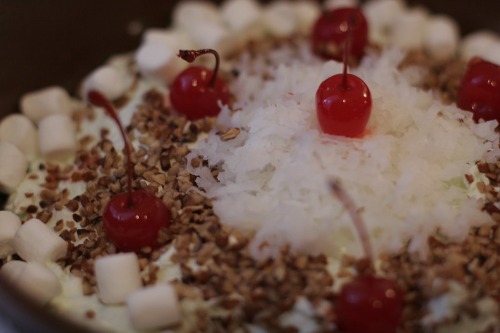
This fruit-and-marshmallow concoction feels like a relic from the mid-century church potluck era. Ambrosia Salad somehow survived America’s shift toward “fresh and clean eating” by holding on tight to canned fruit cocktail and Cool Whip. It’s technically a dessert masquerading as a “salad,” which makes it a charming oddity on holiday tables. Despite the rise of fresh fruit platters, you can still spot it at Southern gatherings and retro-inspired cookouts.
The reason it survives is nostalgia—grandmothers and aunts keep it alive at Thanksgiving or Easter. Younger generations may side-eye the fluorescent maraschino cherries, but they’ll still grab a scoop. It represents a time when processed foods were celebrated for convenience. Health regulations never banished it because the ingredients are all FDA-approved, even if they lean heavy on sugar.
3. Jell-O Salad

Jell-O Salad has managed to wobble its way through decades of changing food standards. Once seen as a clever way to suspend fruit, vegetables, and even mayonnaise, this dish embodies mid-20th-century culinary experimentation. Despite its reputation as a questionable potluck contribution, Jell-O itself has remained a safe, regulated product. That made it immune to the kind of scrutiny that eliminated other quirky processed foods.
People keep making it because it’s visually striking and often tied to family traditions. There’s also an undeniable kitsch appeal in serving neon-colored gelatin studded with pineapple. Kids tend to love it, which guarantees its longevity on buffet tables. Even as we mock it, we secretly enjoy a bite or two when it shows up.
4. Spam Musubi
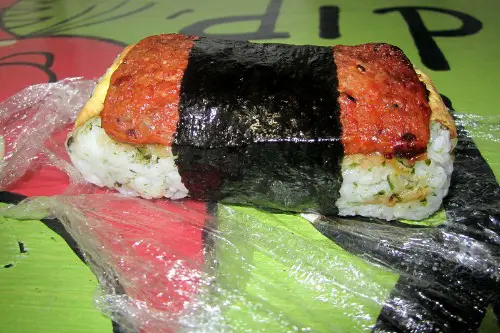
Spam has faced decades of criticism for being overly processed and sodium-heavy, but it’s never been regulated out of existence. In Hawaii, Spam Musubi—Spam atop rice, wrapped in seaweed—has become a beloved staple. This dish survived health-conscious trends by leaning into cultural identity rather than nutritional bragging rights. It’s sold in convenience stores, at festivals, and in family kitchens across the islands.
The reason it sticks around is comfort and portability. Spam was introduced to Hawaii during World War II, and locals adapted it into their cuisine. Even though nutritionists warn against overindulgence, Spam Musubi is too tied to local tradition to fade. Food safety rules allow it because Spam itself is shelf-stable and produced under strict standards.
5. Frito Pie

Frito Pie is essentially chili poured over corn chips, often topped with cheese and onions. It’s heavy, salty, and the kind of thing that defies modern low-fat, low-sodium guidelines. But because every ingredient is an approved grocery item, it’s never faced a regulatory challenge. That means it’s free to thrive at state fairs, football games, and roadside diners.
People love it because it’s fun and communal. Sometimes it’s even served straight in the chip bag, making it both novel and convenient. It reflects a certain rebellious streak in American cooking—why use a bowl when you’ve got packaging? Even as nutrition labels got stricter, Frito Pie never went away because it plays to our love of indulgence.
6. Chicken-Fried Steak
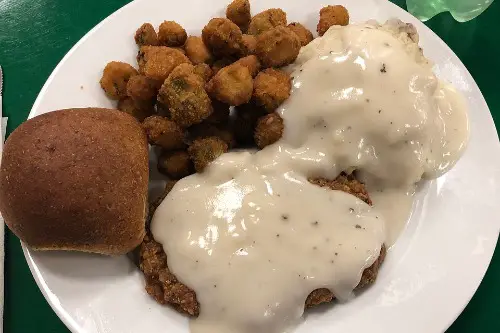
Chicken-fried steak is beef, not chicken, battered and fried until golden, then smothered in creamy gravy. It’s the opposite of what dietary guidelines have encouraged for decades—fried, fatty, and carb-heavy. Yet, it never faced a ban because it’s simply a method of preparation, not a specific product. Health rules can’t outlaw frying flour-dredged beef.
The reason it endures is pure Southern pride. This dish has roots in comfort food traditions and remains a diner menu essential. No matter how many times it’s called unhealthy, its status as a cultural icon saves it. At Sunday brunch buffets and roadside cafes, chicken-fried steak refuses to disappear.
7. Corn Dog

Corn dogs—hot dogs dipped in cornmeal batter and deep-fried—remain a fairground favorite. With nitrates in hot dogs and fried batter, they’re hardly the poster child for wellness. But since both hot dogs and fried foods remain federally legal, corn dogs dodge regulation. They embody classic American carnival food that thrives despite dietary warnings.
Their survival is tied to nostalgia and fun. A corn dog isn’t just food—it’s part of an experience at a ball game or state fair. Handheld and portable, it fits the on-the-go lifestyle Americans love. Even frozen corn dogs at the grocery store keep the tradition alive at home.
8. Biscuits and Gravy
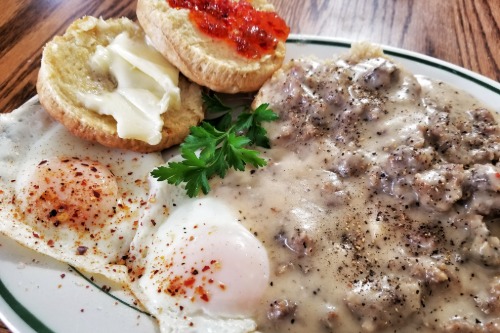
This dish pairs fluffy biscuits with a heavy sausage-and-cream gravy. It’s loaded with saturated fat and sodium, which would seem ripe for regulatory pushback. But the individual components—flour, sausage, milk—are all everyday ingredients. That makes it untouchable by food safety laws.
Its endurance comes from being quintessentially Southern. Biscuits and gravy are a breakfast comfort that connects generations. Even in health-conscious times, restaurants still proudly feature it. It’s a dish too tied to identity to be abandoned, no matter the calorie count.
9. Chipped Beef on Toast

Known as “SOS” in military slang, chipped beef on toast is a mix of dried beef in white sauce poured over bread. It’s high in salt and carbs, but the ingredients themselves remain perfectly legal. It has military roots that gave it staying power among veterans and their families. While it’s not trendy, you can still find it in diners and military-themed eateries.
It persists because it tells a story. Veterans introduced it to households, and nostalgia keeps it alive on menus. Even though it’s mocked as humble or bland, its cultural footprint is significant. Regulations never touched it because dried beef and milk gravy are basic staples.
10. Velveeta-Based Cheese Dip
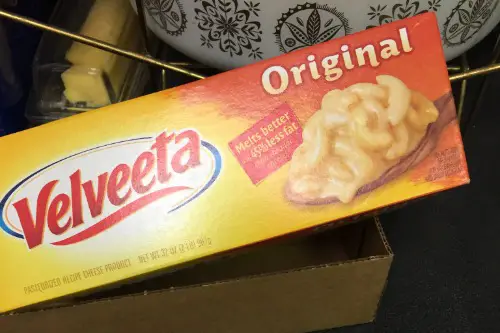
Velveeta isn’t technically cheese—it’s a “pasteurized prepared cheese product.” Still, it’s been the backbone of queso dips and casseroles for decades. Some purists scoff at its artificial nature, but regulators have kept it legal and widely available. That’s why Velveeta-based dips are still a Super Bowl party essential.
It survives because it melts like nothing else. Whether mixed with salsa or chili, Velveeta creates the smooth texture people crave. Home cooks turn to it for foolproof party food. Even as artisan cheeses gained popularity, Velveeta never lost its stronghold in comfort cooking.
11. Funeral Potatoes

This casserole of shredded potatoes, cheese, cream soup, and cornflake topping is a comfort food bomb. It’s standard at gatherings in the Mountain West and Midwest, especially church suppers. While packed with fat and sodium, none of its components fall under banned categories. That means it dodges regulation with ease.
It thrives on community tradition. The name itself comes from its role at post-funeral meals, where comfort food was essential. People keep making it because it’s cheap, filling, and universally liked. Even nutrition guidelines can’t compete with its emotional pull.
12. Bologna Sandwiches
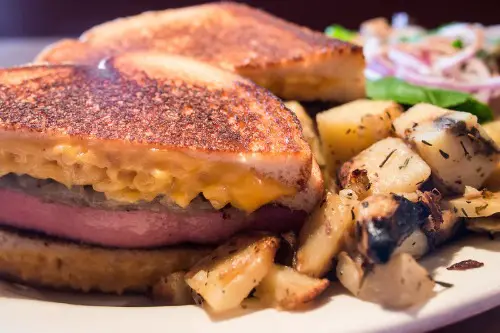
Bologna has been criticized for its high sodium and filler content, but it remains an American lunchbox classic. Stacked on white bread with a slice of American cheese, it represents old-school processed convenience. Bologna faced no regulatory elimination because it meets USDA standards. That allows it to linger in delis and grocery stores.
Its endurance comes from simplicity and cost. Many people grew up with bologna sandwiches, making them nostalgic comfort food. Fried bologna sandwiches in particular remain popular in parts of the Midwest and South. Even though turkey and ham might be healthier, bologna is still a go-to for some households.
13. Grape Salad
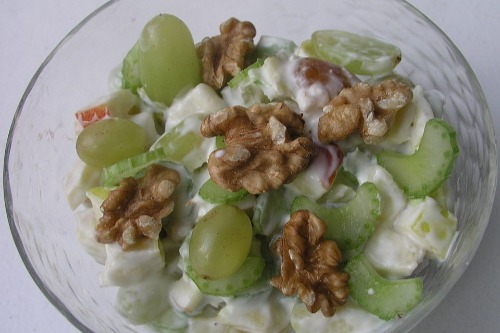
Grape Salad is essentially grapes tossed in a mixture of sour cream, cream cheese, and sugar, topped with brown sugar and sometimes nuts. It sounds like a strange mix, but it’s still a staple in Minnesota and parts of the Midwest. There’s nothing inherently unsafe about it, so regulators never intervened. Despite being sugar-heavy, it continues to show up at potlucks.
Its endurance comes from being deceptively simple yet crowd-pleasing. The creamy dressing contrasts with crisp grapes, creating an oddly addictive dish. While not glamorous, it has a grassroots charm that keeps it alive. It’s proof that sometimes the strangest-sounding dishes last the longest.
This post 13 Recipes That Somehow Survived Decades of Health Regulations was first published on American Charm.


